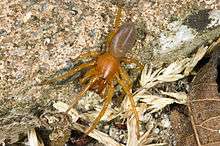Woodlouse spider
| Woodlouse spider | |
|---|---|
 | |
| Scientific classification | |
| Kingdom: | Animalia |
| Phylum: | Arthropoda |
| Class: | Arachnida |
| Order: | Araneae |
| Suborder: | Araneomorphae |
| Family: | Dysderidae |
| Genus: | Dysdera |
| Species: | D. crocata |
| Binomial name | |
| Dysdera crocata C. L. Koch, 1838 | |
 | |
| Synonyms | |
| |
The woodlouse spider, Dysdera crocata, is a species of spider that preys exclusively upon woodlice. Other common names refer to variations on the common name of its prey, including woodlouse hunter, sowbug hunter, sowbug killer, pillbug hunter and slater spider.
Appearance
Female specimens are 15–30 mm long, while males are 10–15 mm. They have six eyes, a dark-red cephalothorax and legs, and a shiny (sometimes very shiny) yellow-brown abdomen. Notably, they have disproportionately large chelicerae. Dysdera crocata is difficult to distinguish from the much less common Dysdera erythrina[1] though this species is not often found near human habitation.
Distribution
D. crocata, which originated in the Mediterranean area, now has a cosmopolitan distribution (see map), ranging from Eurasia to parts of North and South America, South Africa, Australia, and New Zealand.[2]
Behavior
Woodlouse spiders are usually to be found under logs in warm places, often close to woodlice. They have been found in houses. They spend the day in a silken retreat made to enclose crevices in, generally, partially decayed wood, but sometimes construct tent-like structures in indents of various large rocks. Woodlouse spiders hunt at night without the use of a web.
.jpg)
Their diet consists exclusively of woodlice which—despite their tough exoskeleton—are pierced easily by the spider's large chelicerae; the spider is able to inject venom into the woodlouse's soft underbelly while avoiding any noxious defensive chemicals.[2] Laboratory experiments have shown D. crocata will take other invertebrates, and shows no particular preference for slaters; these are simply the dominant prey in its habitat.[2]
The courtship of these spiders is typically aggressive and mates risk injury from each other's large chelicerae. The female lays her eggs in a silken sac and is believed to look after her young after hatching.
They have been known to bite humans if handled. The venom causes no major medical problems. Localized itchiness at the bite site has been reported in some cases.[3]
References
- ↑ Cooke, J. A. L. (June 1965), "Systematic aspects of the external morphology of Dysdera crocata and Dysdera erythrina (Araneae, Dysderidae)", Acta Zoologica, 46 (1-2): 41–65, doi:10.1111/j.1463-6395.1965.tb00726.x
- 1 2 3 Vink, Cor J. (2015). A Photographic Guide to Spiders of New Zealand. Auckland: New Holland. p. 29. ISBN 978-1-86966-403-9.
- ↑ Vetter, R. S.; Isbister, G. K. (2006). "Verified bites by the woodlouse spider, Dysdera crocata". Toxicon. 47 (7): 826–829. doi:10.1016/j.toxicon.2006.02.002. PMID 16574180.
External links
| Wikimedia Commons has media related to Dysdera crocata. |
- Platnick, Norman I. (2008): The world spider catalog, version 8.5. American Museum of Natural History.
- Pictures of Dysdera crocata (free for noncommercial use)
- Harvard Entomology Bug of the Month - Woodlouse hunter
- Dysdera crocata - GeoSpecies Database University of Wisconsin
Further reading
- Rodriguez Gil, S. G., L. M. Mola, A. G. Papeschi & C. L. Scioscia (2002). "Cytogenetic heterogeneity in common haplogyne spiders from Argentina (Arachnida, Araneae)" (PDF). Journal of Arachnology. 30: 47–56. doi:10.1636/0161-8202(2002)030[0047:CHICHS]2.0.CO;2.